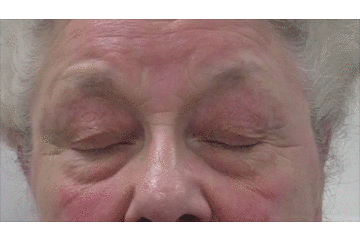Blepharospasm and Hemifacial Spasm
Blepharospasm
Blepharospasm refers to the forceful involuntary closure of the eyes. Blepharospasm sufferers are unable to keep their eyes open when they want to. They may complain of sensitivity to light and general eye discomfort. The sufferer often appears to be suffering from a facial tic or twitching.
Blepharospasm is a very uncommon condition, usually affecting people in the 50s or older. It is commoner in women than men.
Blepharospasm sufferers often find that blepharospasm varies in severity during the day being better in the morning and worse later on in the day. Stress may provoke it. It can be worsened by bright light and any condition which causes ocular irritation e.g. dry eye conditions. In the vast majority of patients, the condition tends to be life long, although in some the condition spontaneously resolves.
The cause of blepharospasm is unknown. Some researchers think that the problem may lie with a parts of the brain which are responsible for movement regulation. Blepharospasm is thought be a localised form of dystonia.
Hemifacial Spasm
Hemifacial spasm is a condition characterised by involuntary twitching and contractions of the muscles on one half of the face. Like blepharospasm, it can be concentrated around the eye but generally tends to be be more diffuse affecting the muscles in the lower face too on the same side e.g. the cheek muscles. The condition may be so diffuse as to affect the muscles on the mouth, neck and forehead- all on the same side
All the muscles on one side of the face are supplied by a nerve called the facial nerve. Hemifacial spasm is thought be due to inappropriate hyperactivity within this nerve causing inappropriate movement of the muscles. In many patients hemifacial spasm develops spontaneously, however in others, hemifacial spasm may occur as result of some problem causing paralysis of the facial nerve itself. In some patients, hemifacial spasm can be caused by irritation of the facial nerve by a blood vessel
Botulinum Toxin Treatment
Botulinum toxin is a neurotoxin protein which is used in tiny amounts to cause temporary controlled paralysis of muscles. It acts by preventing the nerve from releasing its trigger messenger chemicals (neurotransmitter) which tells the muscle to move. There are varous brands of botulinum toxin which have been licensed for the treatment of blepharospasm/ hemifacial spasm including Botox, Dysport and Xeomin. Regardless of brand of Botulinum Toxin, all treatments are given by injecting tiny doses of the medicine into affected muscles.
The duration of botulinum toxin injection treatment varies from patient to patient and for most patients lasts about 3-4 months on average. Therefore a regular treatment programme will be required.
Botulinum toxin is very effective in the vast majority of patients with blepharospasm and hemifacial spasm. However in a small proportion of patients, botulinum toxin injections are not effective e.g. due to side effects, allergies. For botulinum toxin injections to work, the patients needs to realise that accurate dosage of the medicine and repeated regular injections are necessary. It therefore takes some time to slowly establish the exact dosage, where to inject and how often to inject before the patient gets any benefit.
It is crucial to obtain the correct dosage and be accurate and consistent in injection pattern. Side effects occur due to unwanted paralysis of neighbouring muscles causing drooping eyelids (ptosis), double vision. In the vast majority of patients this is very temporary and most patients tolerate these unwanted effects very well.
In a tiny minority of patients in whom botulinum toxin injections are not tolerated, surgery may be necessary.
Links: The Dystonia society
